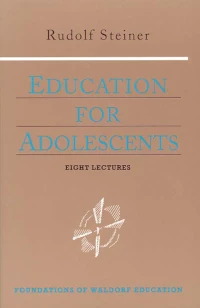Education for Adolescents
GA 302

The present lecture cycle, given in Stuttgart in June 1921 at the opening of the upper or high school and now titled Education for Adolescents, is also known as the Supplementary Course. This name suggests quite clearly that the talks were meant as an expansion and continuation of the cycle The Foundations of Human Experience, which Steiner had presented to the teachers at the opening of the Stuttgart Waldorf (elementary) school two years earlier.
Through these lecture cycles, Steiner advocated a consolidation of interest and interaction of all teachers in the curriculum and teaching methods in the lower and middle elementary schools. Repeatedly in the Supplementary Course lectures, we read that the teachers of the high school should share with their colleagues in the lower grades and kindergarten a common interest in the children’s developmental stages in order to gain a meaningful and true picture of puberty and adolescence.
| Lecture One | June 12, 1921 | |
| Teaching should have a lasting effect on children. The nature of memory. Feelings, humor, expectations as aids of memory. Listening, contemplating- doing, activities. The school as an organism. Harmony of physical and spiritual life. Hygienic effect of lessons | ||
| Lecture Two | June 13, 1921 | |
| Mental images, judgments, conclusions—their connection to head, legs, arms, hands, and feet; their connection to the etheric body, the astral body, and the ego. Head and limbs—their relation to cosmos and earth. Heredity. Connection of the physical/corporeal to soul and spirit. “Cosmic” and “earthly” children. History lessons. Objectivity. Physical education. The teacher’s preparation. | ||
| Lecture Three | June 14, 1921 | |
| Adapting lessons to the children’s lives. Effects on the various constituents during waking and sleeping. Eurythmy, music, physics, history. The complementary effects of subjects. Structuring lessons to adapt to the threefold being. Practical activities and the faculty of forming judgments. The practical aspects of geography. The time element in history. By ignoring the nature of sleep, we produce automata/robots. | ||
| Lecture Four | June 15, 1921 | |
| The School as organism. Connection of the physical/corporeal to soul and spirit. Physical activities–mental activities. Writing, reading, listening to stories. In mental work, the physical organism is predominantly occupied. Salt deposits. The effects of interest, boredom. Eurythmy and singing liberate the spiritual in the limbs. Children with rich and poor imagination. Education interferes in human freedom. Memorizing. Handwork. | ||
| Lecture Five | June 16, 1921 | |
| Radical changes occurring during the fourteenth and fifteenth years. Inner struggle for establishing a relation to the physical. Constitutional differences between girls and boys and their manifestations in behavior. Eroticism. The experience of beauty. The strengthening of the religious/ moral feelings. Different treatment for girls and boys during puberty. Shame; humor; ideals; role models. Education is to lead toward an understanding of life. Class 10 curriculum. | ||
| Lecture Six | June 17, 1921 | |
| Education during puberty demands the teachers’ deeper foundation and understanding of the world. Characteristic features of current educational systems. Interest in current world events a condition for educating children at this age. The youth movements. The Greeks’ relation to and understanding of the different ages. The natural sciences fail to provide a true picture of the human being and the world. The reason why we do not reach the young. The Greeks’ concepts of the four elements. | ||
| Lecture Seven | June 18, 1921 | |
| Human connections between the different age groups. Ignoring the subtleties results in gaps among people. Examples of a knowledge of nature that comprehends life—in the spheres of plants, animals, human beings, and the cosmos. Spiritual-scientific penetration of feeling and sensation as bridge to an understanding of children during puberty. | ||
| Lecture Eight | June 19, 1921 | |
| Inclination toward ideal at ages fourteen and fifteen. Self-chosen authority. Judgments. Protein. Our sciences and universities. Children’s imitation—the continuation of prenatal activities. Cultivation of the search for the truth. The ninth year. Development of the sense of Beauty. Love-duty. Change in the relation to authority. Concluding words. | ||

